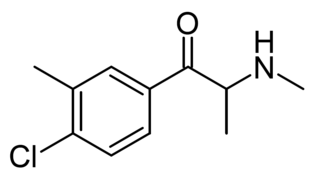
Hydrocodone, also known as dihydrocodeinone, is a semisynthetic opioid used to treat pain and as a cough suppressant. It is taken by mouth. Typically it is dispensed as the combination acetaminophen/hydrocodone or ibuprofen/hydrocodone for pain severe enough to require an opioid and in combination with homatropine methylbromide to relieve cough. It is also available by itself in a long-acting form under the brand name Zohydro ER, among others, to treat severe pain of a prolonged duration. Hydrocodone is a controlled drug: in the United States a Schedule II Controlled Substance.

Methadone, sold under the brand names Dolophine and Methadose among others, is a synthetic opioid agonist used for chronic pain and also for opioid use disorder. It is used to treat chronic pain, and it is also used to treat addiction to heroin or other opioids. Prescribed for daily use, the medicine relieves cravings and removes withdrawal symptoms. Withdrawal management using methadone can be accomplished in less than a month, or it may be done gradually over a longer period of time, or simply maintained for the rest of the patient's life. While a single dose has a rapid effect, maximum effect can take up to five days of use. After long-term use, in people with normal liver function, effects last 8 to 36 hours. Methadone is usually taken by mouth and rarely by injection into a muscle or vein.

Oxycodone, sold under various brand names such as Roxicodone and OxyContin, is a semi-synthetic opioid used medically for treatment of moderate to severe pain. It is highly addictive and is a commonly abused drug. It is usually taken by mouth, and is available in immediate-release and controlled-release formulations. Onset of pain relief typically begins within fifteen minutes and lasts for up to six hours with the immediate-release formulation. In the United Kingdom, it is available by injection. Combination products are also available with paracetamol (acetaminophen), ibuprofen, naloxone, naltrexone, and aspirin.

Hydrocodone/paracetamol is the combination of the pain medications hydrocodone and paracetamol (acetaminophen). It is used to treat moderate to severe pain. It is taken by mouth. Recreational use is common in the United States.

Nortilidine is the major active metabolite of tilidine. It is formed from tilidine by demethylation in the liver. The racemate has opioid analgesic effects roughly equivalent in potency to that of morphine. The (1R,2S) isomer has NMDA antagonist activity. The drug also acts as a dopamine reuptake inhibitor. The reversed-ester of nortilidine is also known, as is the corresponding analogue with the cyclohexene ring replaced by cyclopentane, which have almost identical properties to nortilidine.

Acetylfentanyl is an opioid analgesic drug that is an analog of fentanyl. Studies have estimated acetylfentanyl to be 15 times more potent than morphine, which would mean that despite being somewhat weaker than fentanyl, it is nevertheless still several times stronger than pure heroin. It has never been licensed for medical use and instead has only been sold as a designer drug. Acetylfentanyl was discovered at the same time as fentanyl itself and had only rarely been encountered on the illicit market in the late 1980s. However, in 2013, Canadian police seized 3 kilograms of acetylfentanyl. As a μ-opioid receptor agonist, acetylfentanyl may serve as a direct substitute for heroin or other opioids. Common side effects of fentanyl analogs are similar to those of fentanyl itself, which include itching, nausea and potentially serious respiratory depression, which can be life-threatening. Fentanyl analogs have killed hundreds of people throughout Europe and the former Soviet republics since the most recent resurgence in use began in Estonia in the early 2000s, and novel derivatives continue to appear.

MDMB-CHMICA is an indole-based synthetic cannabinoid that is a potent agonist of the CB1 receptor and has been sold online as a designer drug. While MDMB-CHMICA was initially sold under the name "MMB-CHMINACA", the compound corresponding to this code name (i.e. the isopropyl instead of t-butyl analogue of MDMB-CHMINACA) has been identified on the designer drug market in 2015 as AMB-CHMINACA.

Noroxycodone is the major metabolite of the opioid analgesic oxycodone. It is formed from oxycodone in the liver via N-demethylation predominantly by CYP3A4. Noroxycodone binds to and activates the μ-opioid receptor (MOR) similarly to oxycodone, although with one-third of the affinity of oxycodone and 5- to 10-fold lower activational potency. However, although a potent MOR agonist, noroxycodone poorly crosses the blood-brain-barrier into the central nervous system, and for this reason, is only minimally analgesic in comparison.

2C-B-aminorex (2C-B-AR) is a recreational designer drug with psychedelic effects. It is a substituted aminorex derivative which was first identified in Sweden in June 2019.

5F-JWH-398 is a recreational designer drug which is classed as a synthetic cannabinoid. It is from the naphthoylindole family, and produces cannabis-like effects. It was legally sold in New Zealand from 2012 to 2014 under the psychoactive substances scheme but was discontinued in May 2014 following the end of the interim approval period under the Psychoactive Substances Act 2013. Subsequently, it has appeared on the illicit market around the world and was identified in Germany in May 2019.
The Trans-European Drug Information (TEDI) project is a European database compiling information from different drug checking services located on the European continent. The non-governmental organizations feeding into the database are referred to as the TEDI network.

4-Chloro-3-Methylmethcathinone (4-Cl-3-MMC) is a chemical compound from the substituted cathinone family. It has stimulant effects, and has been sold as a designer drug. It was first identified in Sweden in 2021. It is illegal in Italy and Finland, as well as under generic legislation in various other jurisdictions.

4-HO-MALT (4-hydroxy-N-methyl-N-allyltryptamine) is a tryptamine derivative which has been sold as a designer drug, first being detected in Slovenia in 2021.

3-Fluoro-N-ethylbuphedrone (3F-NEB) is a substituted cathinone derivative with stimulant effects which has been sold as a designer drug. It was first identified in Sweden in 2021.

2-Methyl-alpha-PVP (2-Me-PVP) is a substituted cathinone derivative with stimulant effects which has been sold as a designer drug. It was first identified in Sweden in 2021.

3-Methylmethamphetamine (3-MMA) or Metaphedrine is an amphetamine derivative which has been sold as a designer drug, first being reported in Sweden in 2021.

Deschloroclotizolam is a thienotriazolodiazepine derivative which has been sold as a designer drug, first being identified in Sweden in 2021.

1cP-AL-LAD is an analog of lysergic acid diethylamide (LSD) which has psychedelic effects and is thought to act as a prodrug for AL-LAD. It has been sold as a designer drug, first identified in France in June 2021.

CP 42,096 is an analgesic drug which acts as a cannabinoid agonist. It was developed by Pfizer in the 1980s as part of the research that led to the development of levonantradol, and is more potent than THC but less potent than newer compounds such as CP 55,244.


















